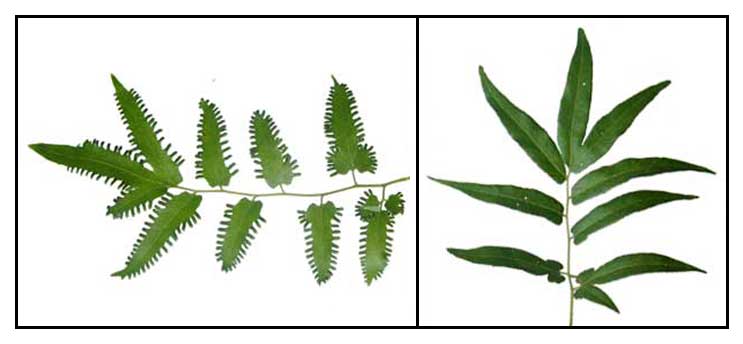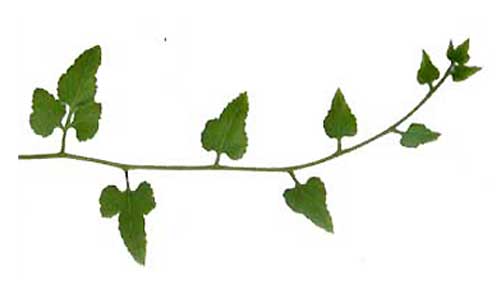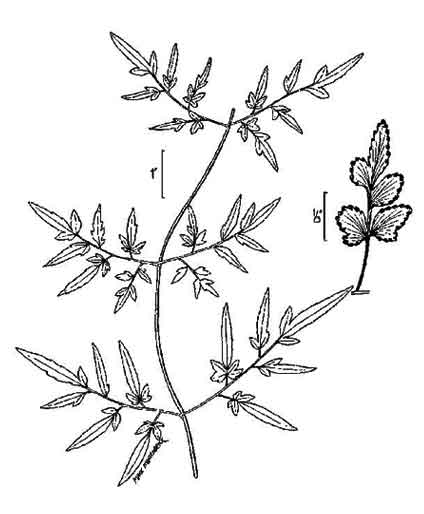 Gen info Gen info
- Lygodium (climbing fern) is a genus of about 40 species of ferns, native to tropical regions across the world, with a few temperate species in eastern Asia and eastern North America.
-
It was first published and described as Ophioglossum japonicum in the family Ophioglossaceae by Carl Peter Thunberg in 1784, and reclassified as Lygodium japonicum by Olof Swartz in 1802. (25)
- Etymology: The specific epithet japonicum is the Latin term for "being from Japan".
Botany
• Nitong-pula is similar to Lygodium flexuosum but is more delicate. It is a very slender, twining fern growing from 1 to 3
meters in length, somewhat pubescent or nearly glabrous, the dwarfed branches 2 to 4 millimeters long. Fronds are of 2 kinds
(dimorphic). Sterile pinnae are 8 to 15 centimeters long, rarely longer, 2 to
4 millimeters wide. Pinnules (leaflets) are 2 to 5 centimeters on each side, the upper ones
simple, sessile, often subconfluent, entire, the intermediate ones somewhat
hastate and the lowest one stalked, pinnate or bipinnate (twice pinnate),
all oblong to linear, 1.5 to 8 centimeters long, tripinnate, the segments relatively
broader and shorter. Spikes (site of the fruiting bodies) are 1 to 6 millimeters
long. Spores are verruculose.
 • The fern produces a creeping stem from which grow very long leaves, the longest exceeding 30 meters (98 feet). Leaves have rachises, which are vine-like and may climb other vegetation. What appear to be individual leaves sprouting from the twining rachis are actually leaflets, which are smaller segments from the main leaf. There are two types of leaflets, sterile and fertile. The sterile frond has lance-shaped segments. The fertile frond has more intricately divided, fringed segments, lined with sporangia on the edges. The plant reproduces via spores and spreads vegetatively via underground rhizomes. (25) • The fern produces a creeping stem from which grow very long leaves, the longest exceeding 30 meters (98 feet). Leaves have rachises, which are vine-like and may climb other vegetation. What appear to be individual leaves sprouting from the twining rachis are actually leaflets, which are smaller segments from the main leaf. There are two types of leaflets, sterile and fertile. The sterile frond has lance-shaped segments. The fertile frond has more intricately divided, fringed segments, lined with sporangia on the edges. The plant reproduces via spores and spreads vegetatively via underground rhizomes. (25)
Distribution
- Native to the Philippines.
-
Very common throughout the
Philippines at low and medium altitudes.
- Also native to Assam, Bangladesh, Cambodia, Caroline Is., China North-Central, China South-Central, China Southeast, East Himalaya, Hainan, India, Japan, Jawa, Korea, Laos, Lesser Sunda Is., Malaya, Maluku, Myanmar, Nansei-shoto, Nepal, New Guinea, Pakistan, Sri Lanka, Sulawesi, Sumatera, Taiwan, Thailand, Tibet, Vietnam, West Himalaya.
- Invasiveness: Lygodium japonicum (Japanese climbing fern) was added to the Florida Noxious Weed List in 1999. It is also a major problem in pine plantations, causing contamination and harvesting problems. (6) In Europe, it was included in the list of Invasive Alien Species of Union concern (the Union List) since 2019.
 Constituents Constituents
- Study isolated a new 1,4-naphthoquinione and three known compounds from the roots. (1)
- Study isolated 8 compounds: tilianin, kaempferol-7-O-alpha-L-rhamnopyranoside, kaempferol, p-coumaric acid, hexadecanoic acid 2, 3-dihydroxy-propyl ester, daucosterol, beta-sitosterol, and 1-hentriacontanol. (7)
- Spores yield caffeic acid and lygodin.
- Study yielded a new phenolic glycoside, 3,4-dihydroxybenzoic acid 4-O-(4′-O-methyl)-β-D-glucopyranoside, from the roots. (13)
- Study yielded flavonols and phenolic acids identified as 3,4-dihydroxyl benzoic acid 4-O-beta-D-(4'-O-methyl) glucopyranoside (1), protocatechuic acid (2), acacetin 7-O-(6'-O-a-L-rhamnopyranosyl)-beta-sophoroside (3), 6,8-di-glucosylapigenin (vinenin) (4), tricin-7-O-beta-D-glucopyranoside (5), 2-anilino-1,4-naphthoquinone (6). (23)
- Study for chemical constituents of roots isolated six compounds: friedelin (1), hydroxyhopane (2), 2α-hydroxyursolic acid (3), daucosterol (4), succinic acid (5), kaempferol-3-O-α-L-rhamnopyranose-7-O-α-L-rhamnopyranoside (6).
(18)
- Ethanol extract of plant yielded
polyphenols, terpenoids, glycosides, saponins, flavonoids, and reducing sugar. (see study below) (20)
- GC-MS analysis for essential oil of whole herb yielded 52 volatile compounds representing 81.70% of the total oil. Main constituents were unsaturated hydrocarbon (30.43%), organic acids (14.926%), ketone (12.818%) and nonterpineols (8.296%). Compounds with contents over 3% (V/V) were 3-methyl-1-pentanol 4.097%, 2-(methylacetyl)- 3-carene 4.25%, eyclooctenone 7.616%, (E)-2-hexenoic acid 12.767% and 1-undecyne 28.611%.
(22)
- Study for chemical constituents isolated 8 compounds and identified as
tilianin (1), kaempferol-7-O-alpha-L-rhamnopyranoside (2), kaempferol (3), p-coumaric acid (4), hexadecanoic acid 2, 3-dihydroxy-propyl ester (5), daucosterol (6), beta-sitosterol (7, and 1-hentriacontanol (8). (35)
Properties
- Sweet tasting, refrigerant;
antifebrile, diuretic.
- Aids lymphatic circulation.
- Expectorant, cathartic, diuretic, anti-urolithiatic.
- Studies have suggested antioxidant, antibacterial, hair growth-promoting, anti-inflammatory
, renal stone inhibiting, cytoprotective, antidiabetic, enzyme inhibitory, invasive, cytochrome P450 3A inhibitory properties.
Parts
utilized
· Entire plant.
· Collect material from May to October.
· Rinse, macerate. Dry under the sun.
· Active principles concentrated in the sporangia of the
plant.
 Uses Uses
Edibility
- Tender frond is edible.
- Young fronds added to dishes like kachuri, chilla (kachru), parantha, pakoras, pasta, poha, omelettes, etc.
- Leaves used in stir-fries and soups.
- In Nepal, young leaves used as vegetable. (32)
Folkloric
- Decoction of 25 - 30 g of dried material
for urinary tract infections, lithiasis, renal edema. cough-fever, reddish
urine, enteritis-dysentery.
- Plant used as expectorant, Decoction of vegetative parts and spores used as diuretic.
Spores used as general blood tonic. Also, as anti-gonorrheal agent. (11)
- Used as a blood tonic and for cold symptoms and urinary and kidney problems.
- In China, used as an expectorant. Also used in hematuria and blennorrhagia. Also used for pneumonia and for dissolving urinary stones.
- In India, the tribal people of Nagaland apply the plant past on eczema and ringworm and wounds.
- Crushed leaves used in treatment of fresh cuts and wounds. (20)
- An ingredient of Chinese medicine Jin Bo Xiao Shi San (mirabilite 100g, Hai Jin Sha [Lygodium japonicum] 100g, Hu Po (Amber) 40 g, and Peng Sha (sodium borate) 20 g—used to treat urolithic stranguria; also used to treat mumps, ascariasis, pruritus. (17)
- In Chinese traditional medicine, spores used for treatment of various inflammatory diseases. (19) Crushed leaves used to treat hepatitis and dysentery. (20) For centuries, used for treatment of gorge gall, eczema, enteritis, nephritis, dropsy, urinary tract infection and stones. (24)
- North American Indians use hair washes derived from L. japonicum and Yucca for treatment of hair loss and thinning. (21)
- In Nepal, paste of spore used on cuts, wounds, boils, and cracked heels. Paste of plant applied to treat pains. (32)
- In India, used for as expectorant and for treatment of of snakebites, diabetes, wounds, ulcers. In Nepal, used for treatment of scabies; juice used for treatment of herpes and wounds and applied to boils, wounds, whitlow, and scabies. In Pakistan, powder applied on wounds to facilitate healing; root extract used to reduce body aches and swelling. (34)
- Miao people in Hainan use juice from pounding of plant for eye problems. (37)
Others
- Basketry: Splints from stems used in basketry, making hats and boxes. Splints sometimes mixed with buri for making fancy articles. (11)
- Ritual: Used for religious purpose by Magar and Majhi especially in "Sauane sakranti", and in decoration of gates during weddings and other celebrations, in decoration of Rato Machindra nath chariot of Patan. (32)
Studies
• Phytochemical Study: Phytochemical study isolated 3,4-dihydroxyl benzoic acid 4-O-beta-D-(4'-O-methyl)glycopyranoside, protocatechuic acid, acacetin 7-O-((6'-O-a-L-rhamnopyranosyl)-beta-sophoroside, venenin, tricin-7-O-beta-D-glycopyranoside, 2-anilino-1,4-naphthoquinone. (3)
• Ecdysteroside: Phytochemical study of the roots yielded a new ecdysteroside, lygodiumsteroside A, as well as a known ecdysteroside. (4)
• Hair Growth Promotion / Spores: Aqueous ethanol extract of spore of Lygodium japonicum showed in vitro testosterone 5a-reductase inhibitory activity and in vivo anti-androgenic activity with hair regrowth after shaving in testosterone-treated mice. Study yielded lipophilic constituents, oleic acid, linoleic and palmitic acids, identified as the main active principles inhibiting 5-alpha reductase. (5)
• Antioxidant / Antibacterial / Purification Polysaccharides: Extracted purification polysaccharides showed strong antioxidant activity in various assays and also showed to be a potential source of natural broad-spectrum anti-microorganism. (8)
• Scavenging Activities: Study compared the scavenging activities of total flavone from L. japonicum with different solvents to free radical activity. A 95% ethanol extract had the best scavenging effects. (9)
• Inhibitory Effect on Renal Calculi: Study investigated an ethanol extract of Lygodii spora as preventive and therapeutic agent for experimentally induced calcium oxalate nephrolithiasis in male Wistar rats. Results showed significant decrease in levels of urinary calcium, oxalate, and uric acid, and increased levels of urinary citrate. (12)
• Enhancement of Antioxidant and Antimicrobial Activities: Pressure-assisted water extraction (PAWE) increased the phenol amount of L. japonicum to 12.8 mg GAE/g compared to conventional extraction (9.3 mg GAE/g) (p<0.05). The lowest minimum inhibitory concentrations (MIC99) of L. japonicum extracted by PAWE were 2.59, 3.33, and 7.37 mg/mL, respectively, against Listeria monocytogenes, Salmonella typhimurium, and Propionibacterium acnes. Results suggest PAWE can be an appropriate extraction method for enhancing biological and pharmaceutical properties of medicinal plants. (15)
• New Phenylpropanoid Glucoside / Antioxidant / Aerial Parts: Study of aerial parts isolated a new compound, 4-O-caffeoyl-D-glucopyranose (1), and a new natural product, 3-O-caffeoyl-D-glucopyranose (2), together with six known compounds (3-8). In vitro evaluation of compounds 1-8 showed strong antioxidative properties. (16)
• Anti-Inflammatory / Spores: Study investigated the anti-inflammatory effects of ethanol extracts of L. japonicum spores by measuring inflammatory mediators and exploring molecular mechanisms. Results showed the extracts may suppress LPS-induced inflammatory responses in murine macrophages in vitro, through negative regulation of p38 MAPK and nuclear factor [NF]-kB. Study suggests potential in therapeutic strategies for alleviating inflammation. (19)
• Antibacterial / Antioxidant: Study evaluated three indigenous medicinal plants in Nepal for antioxidant and antibacterial activities i.e., Hibiscus rosa-sinensis, Phlogacanthus thyrsiformis, and Lygodium japonicum. All extracts showed antibacterial properties against four gram negative bacteria ( E. coli, K. pneumonia, S. typhi, P. mirabilis) and two gram positive bacteria (S. aureus, B. subtilis). On antioxidant evaluation using DPPH scavenging activity, L. japonicum showed the highest activity (IC50 of 80 ± 1.3 µg/ml) compared to ascorbic acid (IC50=54 ± 0.5 µg/ml). (see constituents above) (20)
• Renal Stone Inhibiting / Cytoprotective / Polysaccharide: Study evaluated the role of Lygopodium japonicum polysaccharide (LPJ) in inhibiting kidney stone formation. LPJ primarily consists of Glc, Gal-UA, Glc-UA, Gal, Rha, and Ara monosaccharides. LPJis able to absorb onto high-energy (101) crystal surfaces to inhibit calcium oxalate monohydrate (COM) growth, reduce crystal size and promote phase conversion from COM to COD (calcium oxalate dihydrate). LPJ inhibits crystal adhesion and endocytosis. LPJ can be effectively enriched in rat kidneys, significantly inhibiting calcium oxalate (CaOPx) crystal formation in vivo and reducing renal injury. Compared to PC, a conventional stone treatment drug, LPJ demonstrates superior performance in modulating CaOx crystalline formation and cytoprotection. LPJ presents as a potential treatment option for renal stones. (26)
• α-Amylase, α-Glucosidase, DPP-IV Enzymes Inhibitory / Leaves: Study evaluated the inhibitory effects of Lj leaf extracts on α-amylase, α-glucosidase, and dipeptidyl-peptidase IV in vitro. A chloroform extract (CF) exhibited highest inhibitory effect on α-glucosidase with IC50 of 1092.05 µg/mL. Butanol extract showed highest α-amylase and DPP-IV inhibitory activity with IC50s of 227.35 µg/mL and 141.989 µg/mL, respectively. Results suggest a source of leads for development of antidiabetic medicines. (27)
• Invasiveness and Ecological Threat: Lygodium japonicum has manifested invasive tendencies. The paper discusses the mode of introduction and proliferation and need to prepare and formulate specific and effective guidelines in managing future invasion, the contribution of trading, importation, and transport of wildlife in the introduction and spread of Lj. Review includes existing control methods and approaches to ensure effective and sustainable practices and strategies in regulating invasion. (28)
• Effect in Non-Bacterial Prostatitis: Study evaluated the therapeutic effects and mechanism of action of L. japonicum in a rat model of non-bacterial prostatitis induced by castration and testosterone treatment. Control rats showed severe acinar gland atrophy and stromal proliferation. Treated rats showed diminished range of tissue damage. There was decreased number of PCNA positive cell and concurrent increase of TUNEL positive cells in the stroma of Lj treated rats. Results suggest LJ may protect the glandular cells and inhibit stromal proliferation with suppression of cyto-proliferation and stimulation of apoptosis. Results suggest potential for treatment of chronic non-bacterial prostatitis. (29)
 • Effect in Benign Prostatic Hyperplasia: In BPH, dihydrotestosterone acts as a potent cellular androgen and promotes prostate growth. Inhibiting enzyme 5α-reductase, which is involved in the conversion of testosterone to active form dihydrotestosterone reduces the excessive prostate growth. Study evaluated the effects of Lj on cytopathological alterations and expression of 5α-reductase in a rat model of BPH induced by castration and testosterone. Rats treated with Lj showed diminshed range of luminal cells and duct epithelial cell damage, along with decreased stromal elements and connective tissue proliferation. Results suggest Lj may protect gllandular epithelial cells and has potential for treatment of benign prostatic hyperplasia. (30) • Effect in Benign Prostatic Hyperplasia: In BPH, dihydrotestosterone acts as a potent cellular androgen and promotes prostate growth. Inhibiting enzyme 5α-reductase, which is involved in the conversion of testosterone to active form dihydrotestosterone reduces the excessive prostate growth. Study evaluated the effects of Lj on cytopathological alterations and expression of 5α-reductase in a rat model of BPH induced by castration and testosterone. Rats treated with Lj showed diminshed range of luminal cells and duct epithelial cell damage, along with decreased stromal elements and connective tissue proliferation. Results suggest Lj may protect gllandular epithelial cells and has potential for treatment of benign prostatic hyperplasia. (30)
• Inhibitory Effect on Cytochrome P4503A Enzyme / Roots: Study evaluated the interactions of main components of Lygodium root (p-coumaric, acacetin, apigenin, buddleoside, and diosmetin-7-O-ß-D-glucopyranoside) with cytochrome P450 3A enzymatic activity in-vivo and in-vitro. Among the five main components, acacetin and apigenin showed inhibitory effects on cytochrome P450 3A enzyme in vitro. In-vivo, acacetin and apigenin could systemically inhibit midazolam metabolism in rats. Results suggest acacetin and apigenin can inhibit activity of the cytochrome P450 3A enzyme in-vitro and in-vivo, indicating that herbal drug interactions might occur when taking Lygodium root and midazolam synchronously. (31)
• Lygodipenoids / Partial Agonist for Liver X receptor α: Study of whole grass of Lj isolated
Lygodipenoids A and B (1,2). The compounds were tested in transfected cultured human embryonic kidney 2093 HEK293 cells for an agonist assay. Compound 1 was identified as a partial agonist for liver X receptor α. (33)
Availability
Wild-crafted.
Spores and supplements in pill or capsule form, extracts and tinctures in the cybermarket.
|


 Gen info
Gen info • The fern produces a creeping stem from which grow very long leaves, the longest exceeding 30 meters (98 feet). Leaves have rachises, which are vine-like and may climb other vegetation. What appear to be individual leaves sprouting from the twining rachis are actually leaflets, which are smaller segments from the main leaf. There are two types of leaflets, sterile and fertile. The sterile frond has lance-shaped segments. The fertile frond has more intricately divided, fringed segments, lined with sporangia on the edges. The plant reproduces via spores and spreads vegetatively via underground rhizomes. (25)
• The fern produces a creeping stem from which grow very long leaves, the longest exceeding 30 meters (98 feet). Leaves have rachises, which are vine-like and may climb other vegetation. What appear to be individual leaves sprouting from the twining rachis are actually leaflets, which are smaller segments from the main leaf. There are two types of leaflets, sterile and fertile. The sterile frond has lance-shaped segments. The fertile frond has more intricately divided, fringed segments, lined with sporangia on the edges. The plant reproduces via spores and spreads vegetatively via underground rhizomes. (25) Constituents
Constituents Uses
Uses • Effect in Benign Prostatic Hyperplasia: In BPH, dihydrotestosterone acts as a potent cellular androgen and promotes prostate growth. Inhibiting enzyme 5α-reductase, which is involved in the conversion of testosterone to active form dihydrotestosterone reduces the excessive prostate growth. Study evaluated the effects of Lj on cytopathological alterations and expression of 5α-reductase in a rat model of BPH induced by castration and testosterone. Rats treated with Lj showed diminshed range of luminal cells and duct epithelial cell damage, along with decreased stromal elements and connective tissue proliferation. Results suggest Lj may protect gllandular epithelial cells and has potential for treatment of benign prostatic hyperplasia. (
• Effect in Benign Prostatic Hyperplasia: In BPH, dihydrotestosterone acts as a potent cellular androgen and promotes prostate growth. Inhibiting enzyme 5α-reductase, which is involved in the conversion of testosterone to active form dihydrotestosterone reduces the excessive prostate growth. Study evaluated the effects of Lj on cytopathological alterations and expression of 5α-reductase in a rat model of BPH induced by castration and testosterone. Rats treated with Lj showed diminshed range of luminal cells and duct epithelial cell damage, along with decreased stromal elements and connective tissue proliferation. Results suggest Lj may protect gllandular epithelial cells and has potential for treatment of benign prostatic hyperplasia. (

